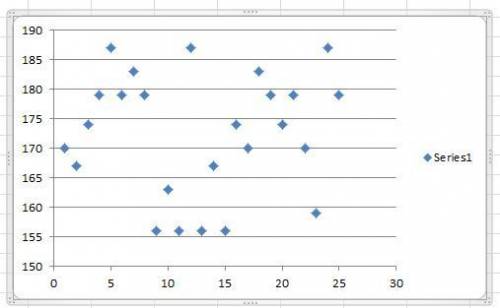
Mathematics, 14.04.2020 19:46 dctjr
An engineer measured the Brinell hardness of 25 pieces of ductile iron from her company, that were subcritically annealed. She believes that the alloys her company uses in iron, will ultimately make the iron stronger, and thus will have a higher Brinell hardness score. She tests 25 pieces of ductile iron from her company with the resulting data of Brinell hardness scores:
170 167 174 179 179 187 179 183 179
156 163 156 187 156 167 156 174 170
183 179 174 179 170 159 187
The engineer hypothesizes that the mean Brinell hardness score of such ductile iron pieces from her company will greater than known average Brinell score for iron which is 170. At the 5% level of significance, is there enough evidence to conclude this?
State the Claims which means to State the null and alternative hypotheses. Use correct math type. You may want to consider looking back at the symbols assignment from the beginning of class.
a. What is the sample mean?
b. What is the sample standard deviation?
c. Are the normality assumptions met?
d. Conclusion. State your conclusion. Either reject or fail to reject H0 , indicate why, then write the conclusion in terms of the problem.

Answers: 1


Other questions on the subject: Mathematics

Mathematics, 21.06.2019 18:30, alizeleach0123
Which representation has a constant of variation of -2.5
Answers: 1

Mathematics, 21.06.2019 20:30, maxy7347go
Does the function satisfy the hypotheses of the mean value theorem on the given interval? f(x) = 4x^2 + 3x + 4, [−1, 1] no, f is continuous on [−1, 1] but not differentiable on (−1, 1). no, f is not continuous on [−1, 1]. yes, f is continuous on [−1, 1] and differentiable on (−1, 1) since polynomials are continuous and differentiable on . there is not enough information to verify if this function satisfies the mean value theorem. yes, it does not matter if f is continuous or differentiable; every function satisfies the mean value theorem.
Answers: 1

Mathematics, 21.06.2019 23:00, ptrlvn01
1. an economy consists of three workers: larry, moe, and curly. each works 10 hours a day and can produce two services: mowing lawns and washing cars. in an hour, larry can either mow one lawn or wash one car; moe can either mow one lawn or wash two cars; and curly can either mow two lawns or wash one car. a. calculate how much of each service is produced under the following circumstances: a. all three spend all their time mowing lawns. b. all three spend all their time washing cars. c. all three spend half their time on each activity d. larry spends half of his time on each activity, while moe only washes cars and curly only mows lawns b. using your answers to part a, draw a production possibilities frontier and label points a, b, c, and d on your graph. explain why the production possibilities frontier has the shape it does. c. are any of the allocations calculated in part a inefficient? explain.
Answers: 3

Mathematics, 21.06.2019 23:40, christinasmith9633
30 ! the graph shows the number of siblings different students have. select from the drop-down menus to correctly complete the statement.
Answers: 1
You know the right answer?
An engineer measured the Brinell hardness of 25 pieces of ductile iron from her company, that were s...
Questions in other subjects:

Mathematics, 24.11.2020 21:50



Mathematics, 24.11.2020 21:50

Mathematics, 24.11.2020 21:50


Chemistry, 24.11.2020 21:50

Business, 24.11.2020 21:50


Mathematics, 24.11.2020 22:00




